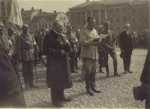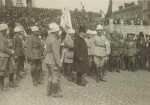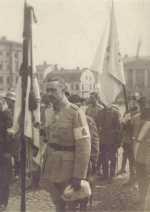

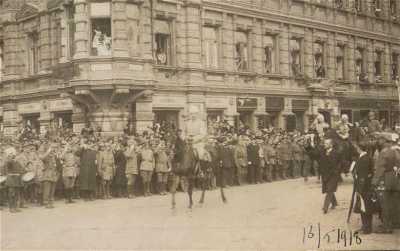
The parade had a strategic purpose as well. Mannerheim prepared for the breakout of war against the Russians on the Karelian Isthmus. The bulk of the western army was concentrated in Helsinki from where its transportation by rail to the eastern front would have been relatively easy. The eastern army was represented in the parade only by individual model detachments, companies or battallions. Later on, the concentration of the troops proved unnecessary, as Germany put a stop to the hostilities on the Karelian Isthmus. The white army was received with cheers in Helsinki
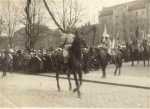 The parade comprised a march into the city, an
inspection and a march-past. 12,000 men participated, accompanied by five separate brass
bands as well as smaller troop bands.
The parade comprised a march into the city, an
inspection and a march-past. 12,000 men participated, accompanied by five separate brass
bands as well as smaller troop bands.
The march of the white army began from the quarter of Töölö, along the street,
presently called Mannerheimintie, and from the neighbourhood of the Stadium, the
Eläintarha sports field and the former Pasila railway station.The Commander-in-Chief and
his staff officers were riding in front; the other troops were grouped into infantry units
led by Commander Wetzer of the Western Army, by the staffs of the Karelian Army Corps, of
Colonel Hjalmarson and of Major General Linder of the Savo Group. These were followed by
artillery, dragoons (the Uusimaa Dragoon Regiment) and cavalry Jägers. The troops who had
participated in the occupation of Tampere, bore as a symbol a fir twig on the left side of
their headpiece. Efforts had been made to dress the yeoman army uniformly for the parade,
at least by regiments, but there was still a lot of variation in the clothing.
Theslöf, the military governor of Helsinki, and Mayor J. von Haartman received the Commander-in-Chief at the end of Läntinen Heikinkatu (later Mannerheimintie), near the site where Mannerheim’s statue is located at present. The parade continued along Läntinen Heikinkatu, Pohjoisesplanadi and Unionkatu to the Senate Square. Only the first sections of the troops marched as far as the square, the other sections continuing their march to the Market Square, Katajanokka and Kruununhaka to wait. Red and yellow flags with lions and flags with diagonal blue and white stripes were flying along and above the streets. The latter-style flags had been composed by taking away the red colour from the Russian tricolor (the Finnish flag).
In connection with the inspection of the troops by the speaker of the Senate and the Commander-in -Chief, the commander made the announcement that the troops present had been given the honorary titles of the White Guard of Finland, the Jäger Regiment of the Guard and the Karelian Regiment of the Guard. The Guards of Lapua, Vöyri and Vaasa were to be integrared into the White Guard.
After the festival service held in the Church of Nicholas (later the Helsinki Cathedral), Mannerheim and the representatives of the government inspected the parade troops near Runeberg’s statue in Pohjoisesplanadi. The group of the Jägers, with the Jäger flag dedicated in Libau on the 13th of February 1918 flying in front, and the staff officers of the Karelian army corps led by Aarne Sihvo were applauded the most vehemently. The Swedish Brigade was also well represented
The Parade Day, the 16th of May, was celebrated as the Flag Day of the Army until the year 1942, and a parade was organized on that day until the year 1939.
Commander-in-Chief 1918 | Headquarters 1918
| Vaasa Senate | Hannes Ignatius
| Martin Wetzer | Harald Hjalmarson
| Ernst Linder | Gösta Theslöf | Jägers | St Petersburg Question | Relations with Germany | Cross of Liberty
| Eastern Karelia | Uusimaa Dragoon
Regiment | Fir Twig | Finnish Flag
| Swedish Brigade | Civil Guards | Jäger Conflict | Heikki Kekoni | Red Prisoners | Wilhelm Thesleff
| Aarne Sihvo | Rudolf Walden |
Air Force - Air Weapon | Red and White
Terrorism | Great Parade 16 May, 1918 | Åland Question | Monarchy | Mannerheim's Resignation
COURSE OF LIFE | FAMILY | TIME OF GROWTH | MILITARY CAREER | WAR OF INDEPENDENCE | REGENT 1918-1919 | CIVILIAN | DEFENCE COUNCIL | COMMANDER-IN-CHIEF 1939-1946 | PRESIDENT OF THE REPUBLIC 1944-1946 | RETIREMENT | SPECIAL TOPICS | SEARCH
